The 6TB Red Pro builds on WD’s portfolio of purpose-built hard drives for NAS, offering a 50% capacity boost over the previous highest capacity model (4TB WD Red Pro). The Red Pro family is designed to address the needs of those using storage systems up to 16 bays, ideal for SMBs and remote/branch offices that rely on NAS storage. Red Pro drives differentiate form the Red line with faster 7K spindle speed, extended thermal burn-in testing, hardware-based vibration compensation and a longer warranty.
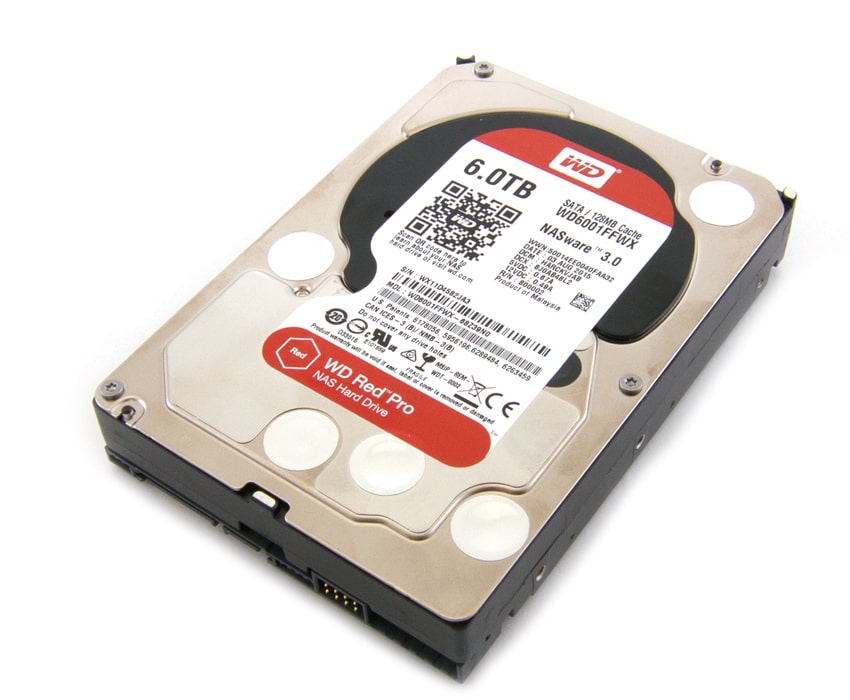
The WD 6TB Red Pro is aimed at organizations that need generous amounts of capacity in their larger NAS devices. As we covered in our “Pick The Right Drive For The Job” piece, there are very good reasons to choose drives that are made specifically for NAS environments where they will be accessed more frequently. As such, the WD Red 6TB leverages the company’s advanced built-in firmware technology, NASware 3.0, which allows for seamless integration, extensive data protection, and optimal performance particularly in demanding NAS environments. Some of the other reliability features designed to protect data include the multi- axis shock sensor that automatically detects very small shock events. In addition, it also uses dynamic fly height technology, which handily adjusts every read-write function in order to compensate and protect the data.
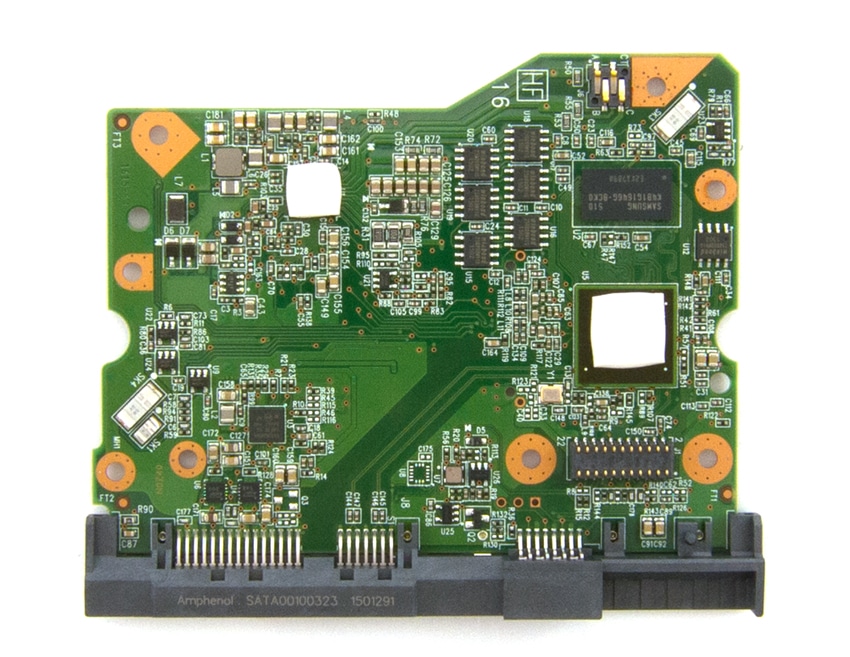
Backed by a 5-year warranty, the WD Red Pro HDD comes in capacities of 6TB, 5TB, 4TB, 3TB and 2TB, which allow it to address a variety of use cases.
WD Red Pro Specifications
- Capacities: 6TB (WD6001FFWX), 5TB (WD5001FFWX), 4TB (WD4001FFSX), 3TB (WD3001FFSX), 2TB (WD2001FFSX)
- Interface: SATA 6 Gb/s
- Form Factor: 3.5 Inch
- RPM: 7200
- Cache: 64MB
- Advanced Format
- Native command queuing
- RoHS compliant
- Data transfer rate (max):
- Buffer to host 6 Gb/s
- Host to/from drive (sustained): 214MB/s (6TB), 194MB/s (5TB) 171MB/s (4TB), 168MB/s (3TB), 164MB/s (2TB)
- Reliability/Data Integrity
- Load/unload cycles: 600,000
- Non-recoverable read errors per bits read: <10 in 1015
- MTBF (hours) for 8-16 bay NAS: 1,000,000
- Limited warranty (years): 5 years
- Power Management
- 12VDC-/+10% (A, peak): 1.9
- Average power requirements (W)
- Read/Write: 10.6 (6TB, 5TB), 8.6 (4TB), 8.6 (3TB) 6.5 (2TB)
- Idle: 7.6 (6TB, 5TB), 6.5 (4TB), 6.5 (3TB), 4.9 (2TB)
- Standby/Sleep: 1.4 (6TB, 5TB), 0.6 (4TB), 0.6 (3TB), 0.4 (2TB)
- Temperature (°C):
- Operating: 5 to 60
- Non-operating: -40 to 70
- Shock (Gs):
- Operating (2 ms, read/write): 30
- Operating (2 ms, read): 65
- Non-operating (2 ms): 300
- Acoustics (dBA)
- Idle: 31
- Seek (average): 34
- Physical Dimensions
- Height (in./mm, max) 1.028/26.1
- Length (in./mm, max) 5.787/147
- Width (in./mm, ± .01 in.) 4/101.6
- Weight (lb./kg, ± 10%) 1.66/0.75
Enterprise Synthetic Workload Analysis
Our synthetic enterprise storage benchmark process begins with an analysis of the way the drive performs during a thorough preconditioning phase. Each of the comparable drives are secure erased using the vendor’s tools, preconditioned into steady state with the same workload the device will be tested with under a heavy load of 16 threads with an outstanding queue of 16 per thread, and then tested in set intervals in multiple thread/queue depth profiles to show performance under light and heavy usage.
Preconditioning and Primary Steady State Tests:
- Throughput (Read+Write IOPS Aggregate)
- Average Latency (Read+Write Latency Averaged Together)
- Max Latency (Peak Read or Write Latency)
- Latency Standard Deviation (Read+Write Standard Deviation Averaged Together)
Our Enterprise Synthetic Workload Analysis includes two profiles based on real-world tasks. These profiles have been developed to make it easier to compare to our past benchmarks as well as widely-published values such as max 4k read and write speed and 8k 70/30, which is commonly used for enterprise drives.
- 4k
- 100% Read or 100% Write
- 100% 4k
- 128k (Sequential)
- 100% Read or 100% Write
- 100% 128k
In the following section of this review, we will show the performance of both iSCSI and CIFS configurations of the new 3.5″ WD Red Pro 6TB HDDs. WD supplied StorageReview with 8 samples of their new HDDs, which we configured in RAID10 in our Synology DiskStation DS1815+.
We will compare it to the WD Red 6TB (non-Pro) model from the WD line.
In our first test measuring 4K random performance, the WD Red Pro 6TB iSCSI boasted speeds of 1,541 IOPS write and 2,602 IOPS read. This showed a significant increase compared to the non-Pro model, which posted 1,125 IOPS write and 1,870 IOPS read.
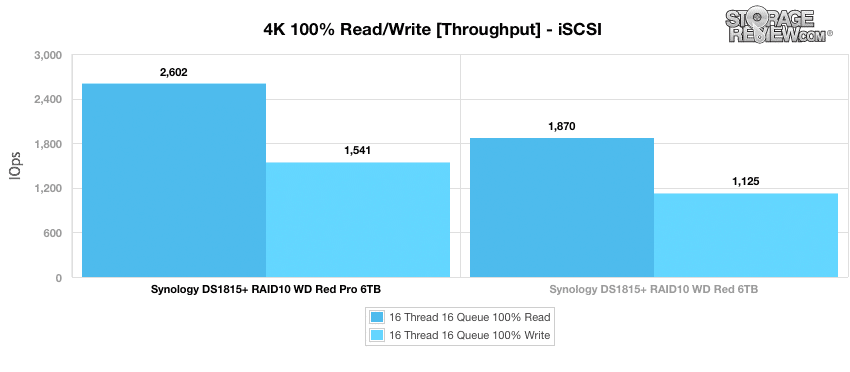
When looking at our CIFS file-level storage test, the WD Red Pro 6TB measured 599 IOPS read and 2,243 IOPS write while the non-Pro model showed 438 IOPS read and 1,862 write.
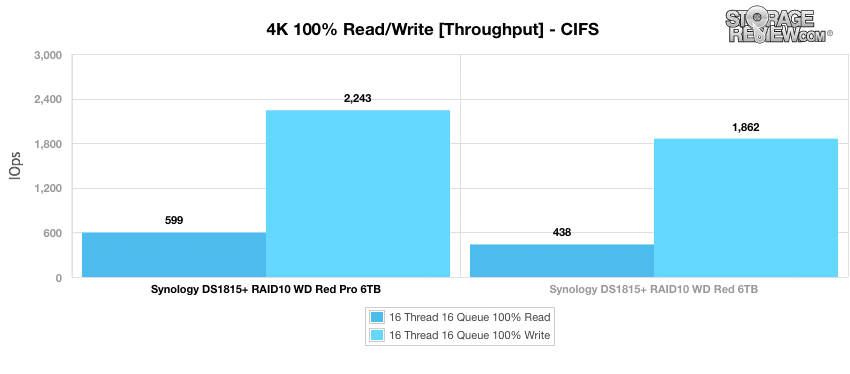
For average latency, the WD Red Pro posted WD Red Pro 6TB 98.35ms read and 166.10ms write during the iSCSI block-level test. The WD Red 6TB showed average reads and writes 136.87ms and 227.66ms respectively.
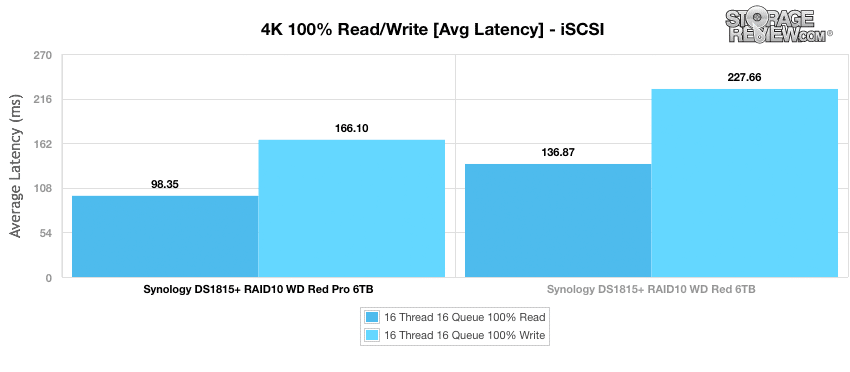
For CIFS, the WD Red Pro showed 426.90ms read and 114.08ms write in average latency compared to the 584.56ms read and 137.53ms write for the non-Pro model.
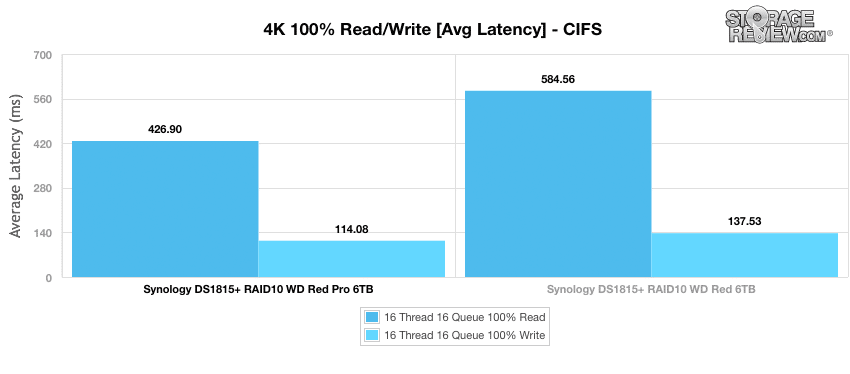
Looking at max latency shows the WD Red Pro with better write latency at 1,127.1ms, though reads were slower than the non-Pro model, which boasted 894.9ms (compared to the Pro’s 945.6ms).
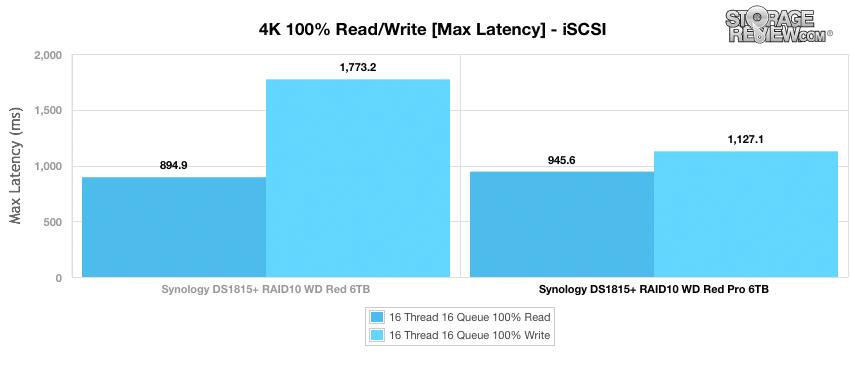
The WD Red 6TB drive posted 1,792.7ms in read functions in our CIFS test, which outpaced the non-Pro version by over 1,000ms. In write latency, however, the WD Red showed the best results with 1,677.8ms.
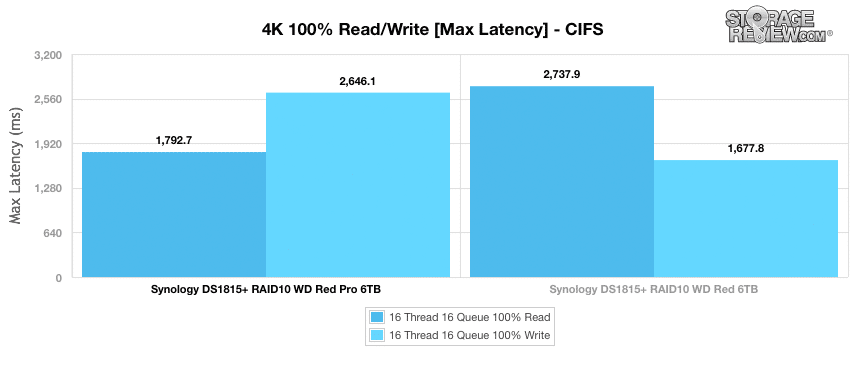
Standard deviation of the WD Red Pro 6TB in an iSCSI environment showed 87.645ms read and 127.90ms write to demonstrate its consistency. This was a great improvement on the non-Pro model, which measured 279.93ms write and 103.49ms read.
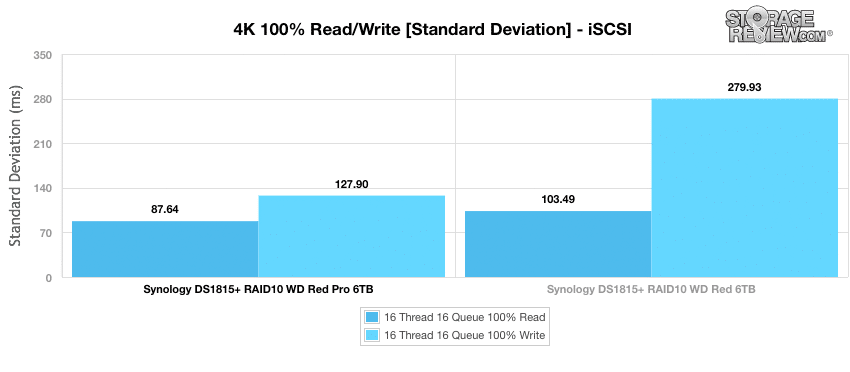
During our CIFS file-level storage test, latency results were much higher. The WD Pro model posted 362.69ms read and 135.75ms write while the non-Pro drive had a significantly slower 755.84ms read and a 158.81ms write.
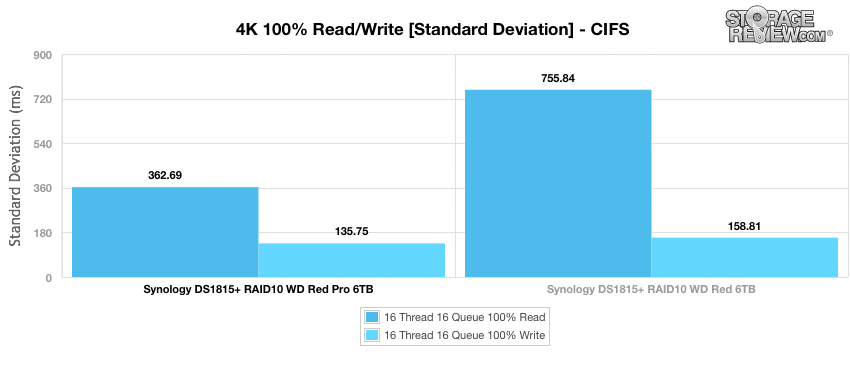
The next test tests the WD drives under 100% read/write activity, this time at 8K sequential throughput. In iSCSI, the WD Pro boasted its top read performance of 28,110 IOPS; however, its write speeds were significantly lower than the non-Pro model, which boasted 24,439 IOPS write (vs. the Pros 13,713 IOPS).
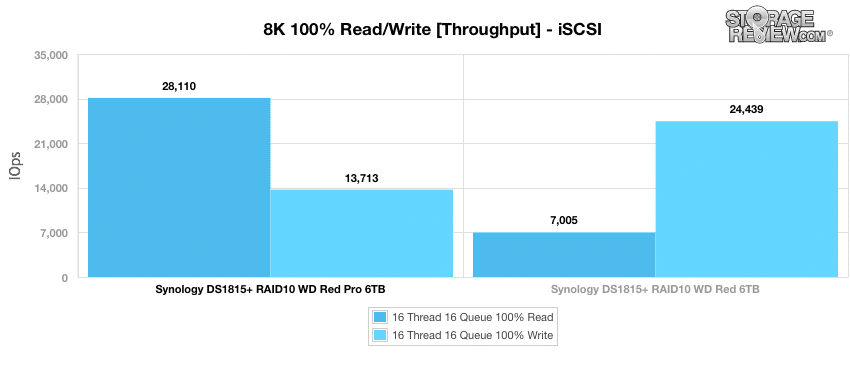
In CIFS, the results between the two WD Red drives were similar to one another. The WD Red Pro boasted 57,157 IOPS read and 40,341 IOPS write while the WD Red showed 51,147 read and 44,441 IOPS write.
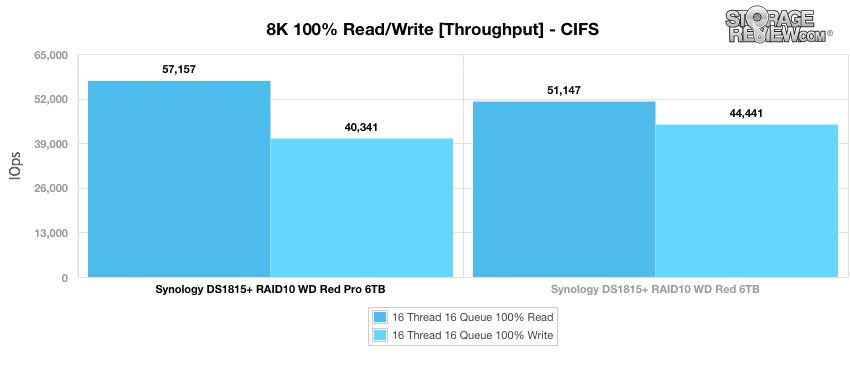
Our next test shifts focus from a pure 4K random read or write scenario to a mixed 8K 70/30 workload where we will show how performance scales in a setting from 2T/2Q up to 16T/16Q. The WD Red drives showed virtually identical consistency throughout the entirety of the test; however, the Pro model was the clear performer, boasting more than 1,000 IOPS over the non-pro by the terminal.
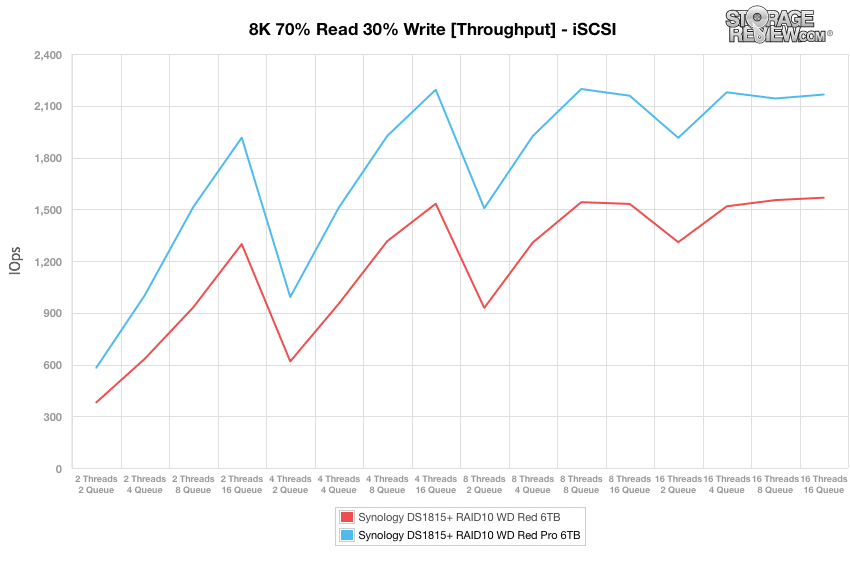
Looking at throughput in CIFS, though the drives boasted significantly less IOPS, it showed a much more consistent level of performance. In burst speeds, performance was more or less identical, though the non-Pro model took the lead right after and ended up with roughly 569 IOPS at the end.
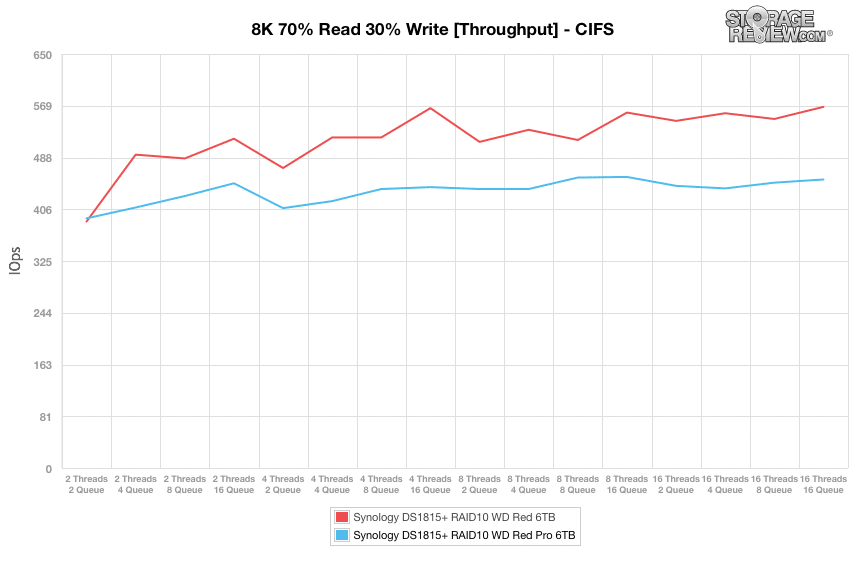
Just like in iSCSI throughput, average latency showed identical consistency between the two drives, with the Pro model boasting slightly better performance.
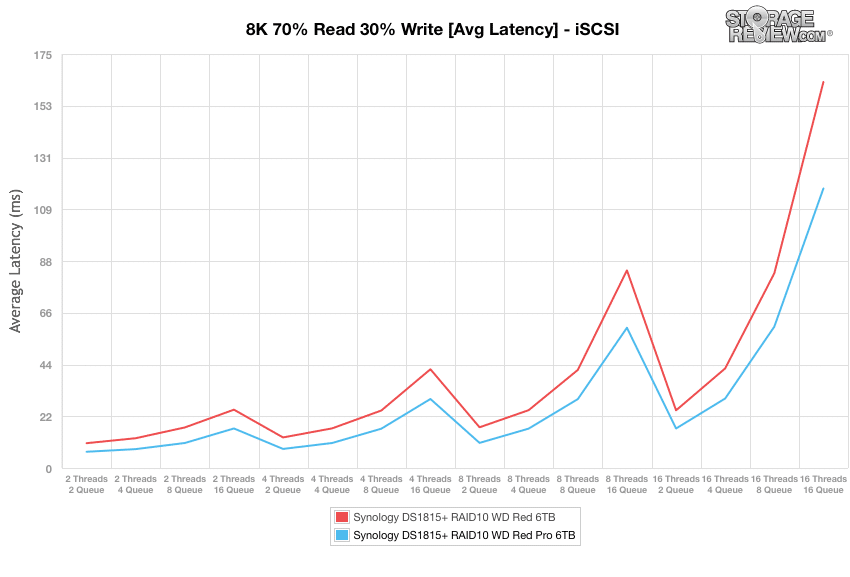
When looking at average latency during our CIFS test, results were also near identical (even more so) with the non-Pro model edging out the WD Red Pro with just over 50ms in the terminal queue depths.
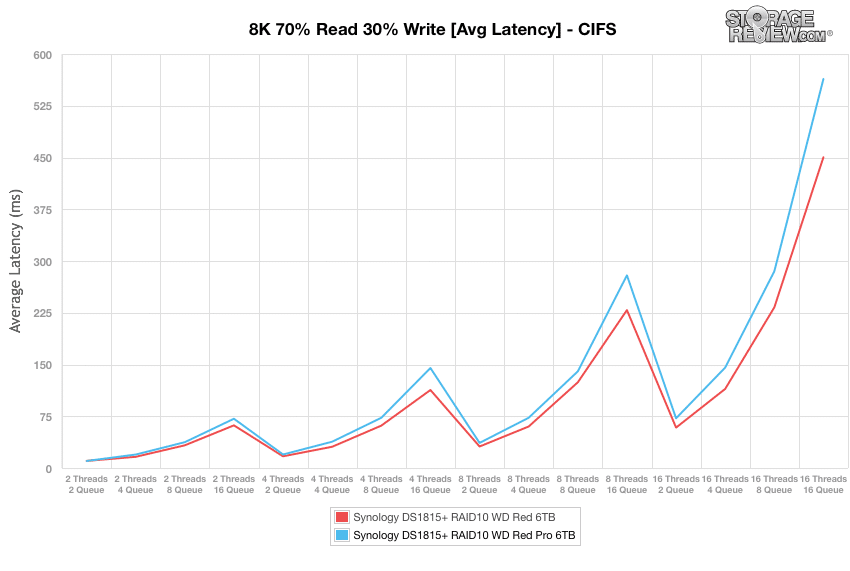
Moving to max latency (iSCSI), both drives showed inconsistent results; however, the Pro-model had a lower latency throughout the majority of the test with approximately 1,300ms in peak latency.
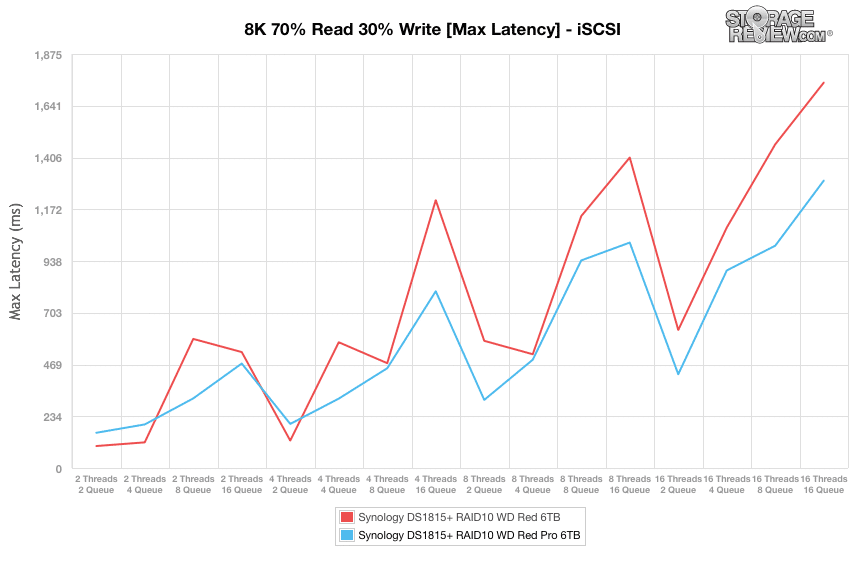
In CIFS, results were also fairly inconsistent across the board; though the performance discrepancy was much more pronounce between the two drives. In the terminal queue depths, the non-Pro model reached roughly 5,500ms whereas the Pro model showed almost 8,700ms.
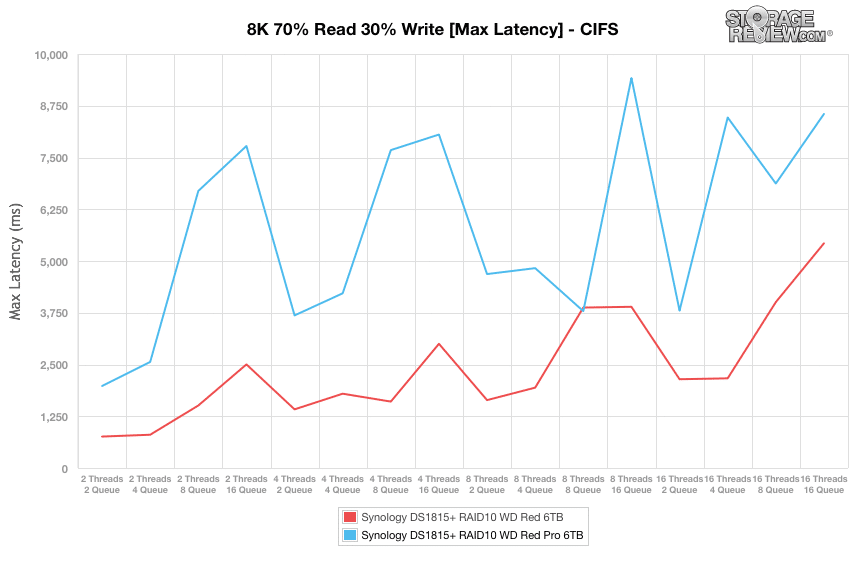
Standard deviation showed similar performance (when compared to average latency readings) in iSCSI, as the two WD drives boasted very similar results in consistency. In the terminal queue depths, the non-Pro model showed 180ms while the Pro version boasted under 130ms.
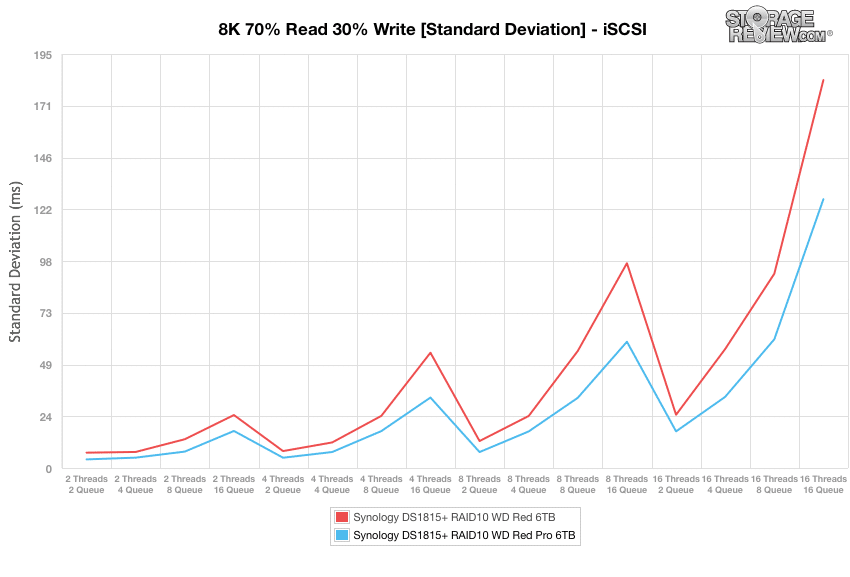
Results were a little bit closer in standard deviation during our CIFS file-level storage test, as performance went back and forth in the second half of our queue depths. By the end, the WD Pro had the better performance with just under 438ms in latency (compared to the non-Pro’s ~480ms).
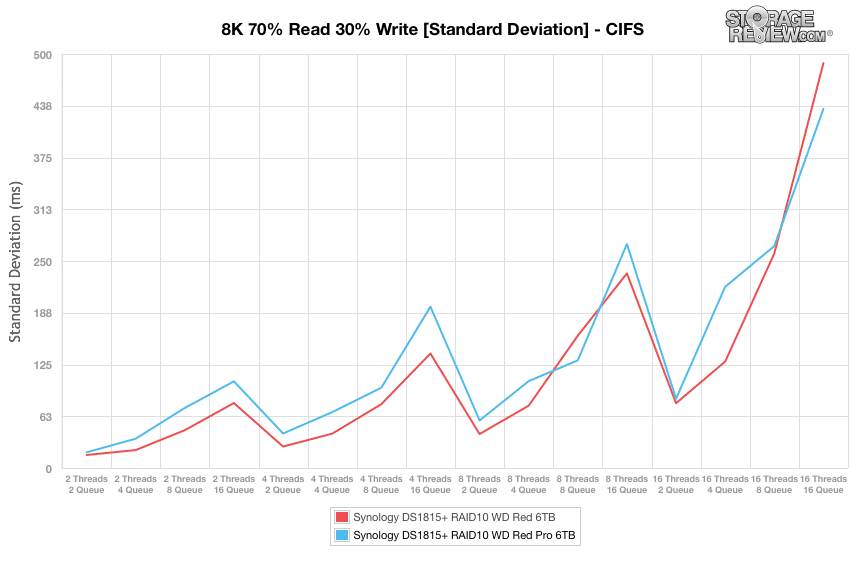
Our last test looks at large-block sequential performance. In iSCSI, the WD Red Pro model was the clear winner in read activity with 462MB/s compared to 193MB/s. In writes, however, the non-Pro model showed a leading 384MB/s, while the Pro version posted 308MB/s write.
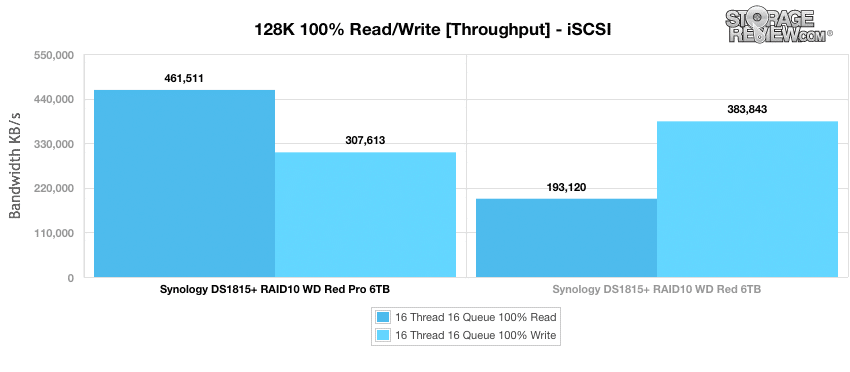
In CIFS, our large-block results were virtually identical between the two WD drives. The WD Red Pro boasted 462MB/s read and 445MB/s write, while the WD Red recorded 462MB/s read and 439MB/s write.
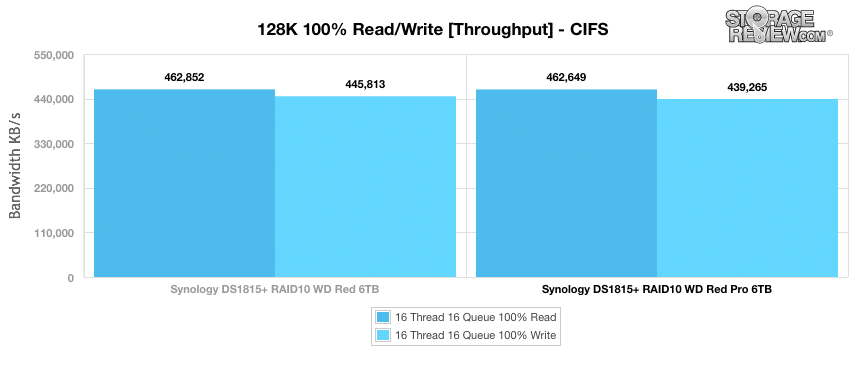
Conclusion
WD has packed the Red Pro with various features that are designed to increase its reliability, compatibility, and performance with NAS devices like the Synology DiskStation we tested it with. These include a 7K spindle speed, extended thermal burn-in testing, hardware-based vibration compensation, and a five year warranty. In addition, the Red Pro drives feature NASware version 3.0, WD’s hard drive firmware designed specifically for NAS solutions.
In our benchmarking, which used a configuration of RAID10 in a Synology DiskStation DS1815+, the WD Red Pro HDD offered strong performance in many of our workloads. In 4K random performance, the WD Red Pro showed a significant improvement on the WD Red model when it came to both sequential transfer speeds and latency readings. Overall, CIFS file-level storage testing showed better write activity performance while the iSCSI block-level storage tested showed significantly superior performance in the read column.
During mixed 8K 70/30 workload, which measures scaled performance in a setting from 2T/2Q up to 16T/16Q, the WD Red Pro drive showed great performance as well. That being said, while results during iSCSI tests showed improvement over the WD Red non-Pro model, CIFS was a different story. Here, the WD Red had better results; sometimes by a significant margin, such as with max latency. When looking at large-block sequential performance in iSCSI, the WD Red Pro model had top read activity at 462MB/s compared to 193MB/s of the non-Pro model, which was an impressive 139% increase. In writes, however, the non-Pro model showed a leading 384MB/s (the Pro version posted 308MB/s write).
Pros
- Strong performance compared to non-Pro 6TB Red
- Capacities now matching WD Red-series
Cons
- Some areas, like CIFS mixed 8K 70/30 workload, showed weaker performance than standard Red
Bottom Line
Packed with entperise-grade features to promote logevity and reliability, the WD Red Pro 6TB drives are high-capacity NAS drives that allow users to maximize their storage and performance capabilities in a NAS environment.
WD Red Pro at Amazon



 Amazon
Amazon